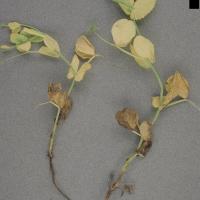Diagnosing seedling root rot in field peas
Root rots caused by Fusarium spp, Pythium spp and Phytophthora spp are major problems in some regions of the eastern states, particularly where crops are grown on stored soil moisture, but these diseases are rare in Western Australia.
What to look for
- Areas or scattered seedlings that fail to emerge or wilt and die, or survive but lack vigour.
- Symptoms are worse where plants are stressed, such as cold wet areas of a paddock.
Paddock
- Sudden death or yellowing and death of older leaves that progresses up the plant
- Poorly developed and rotting root systems. Symptoms include root browning, pruning ,soft watery lesions.
- Roots on Fusarium wilt affected plants appear normal, but the interior of the tap root and often the stem is light orange to brick red.
Plant
What else could it be
| Condition | Similarities | Differences |
|---|---|---|
| Diagnosing group C herbicide damage in field peas | Older leaf necrosis and seedling death | Roots lack characteristic lesions. |
| Diagnosing salinity damage in field peas | Germination failure, older leaf necrosis and seedling death | Roots lack characteristic lesions. |
| Diagnosing waterlogging in narrow-leafed lupins and field peas | Germination failure, older leaf necrosis and seedling death | Roots lack characteristic lesions. |
Where did it come from?
- These are natural soil fungi that persist in the soil for many years
Management strategies
- Use high vigour seed.
See also
Further information
Where to go for expert help
Page last updated: Wednesday, 13 May 2015 - 4:15pm


